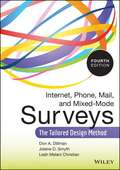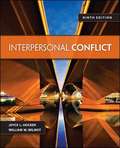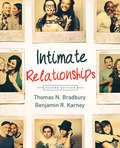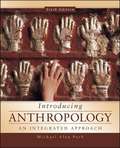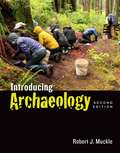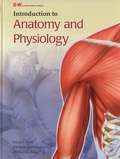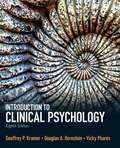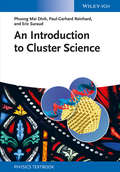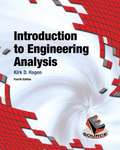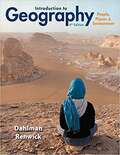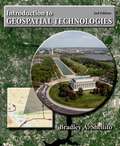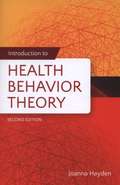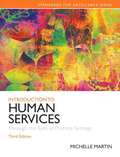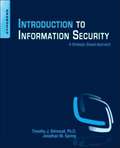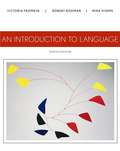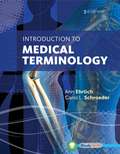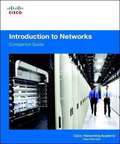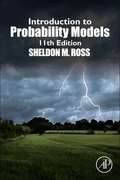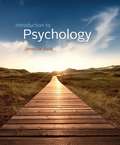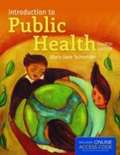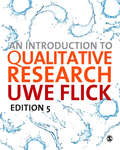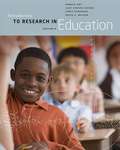- Table View
- List View
International Law: Cases and Materials (6th Edition)
by Lori F. Damrosch Sean D. MurphyThis classic international law casebook has been updated to cover recent case law, including the International Court s Extradite or Prosecute (Belgium v. Senegal) case, and the Supreme Court s decisions in Samantar v. Yousef (on foreign sovereign immunity) and Kiobel v. Royal Dutch Petroleum (on the Alien Tort Statute). With extraordinary range and depth, this casebook probes "hot topics" such as the Syrian civil war, the seizure of pirates, and the ICC's indictments of African leaders, all calculated to provoke engaging classroom discussions. This casebook is designed for introductory and advanced classes, with detailed readings on the structure and actors of international law and on specialized areas.
Internet, Phone, Mail, and Mixed-Mode Surveys: The Tailored Design Method (Fourth Edition)
by Don A. Dillman Leah Melani Christian Jolene D. SmythThe classic survey design reference, updated for the digital age For over two decades, Dillman's classic text on survey design has aided both students and professionals in effectively planning and conducting mail, telephone, and, more recently, Internet surveys. The new edition is thoroughly updated and revised, and covers all aspects of survey research. It features expanded coverage of mobile phones, tablets, and the use of do-it-yourself surveys, and Dillman's unique Tailored Design Method is also thoroughly explained. This invaluable resource is crucial for any researcher seeking to increase response rates and obtain high-quality feedback from survey questions. Consistent with current emphasis on the visual and aural, the new edition is complemented by copious examples within the text and accompanying website. This heavily revised Fourth Edition includes: Strategies and tactics for determining the needs of a given survey, how to design it, and how to effectively administer it How and when to use mail, telephone, and Internet surveys to maximum advantage Proven techniques to increase response rates Guidance on how to obtain high-quality feedback from mail,electronic, and other self-administered surveys Direction on how to construct effective questionnaires,including considerations of layout The effects of sponsorship on the response rates of surveys Use of capabilities provided by newly mass-used media:interactivity, presentation of aural and visual stimuli. The Fourth Edition reintroduces the telephone-including coordinating land and mobile. Grounded in the best research, the book offers practical how-to guidelines and detailed examples for practitioners and students alike.
Interpersonal Communication and Human Relationships
by Mark L. Knapp Anita L. Vangelisti John P. CaughlinThis title introduces students to interpersonal communication principles and theories through the use of commonplace experiences, such as relationships with roommates, friends and co-workers. The book aims to motivate students to critically think about their own relational communication; it also peaks student interest in social science research. <p><p>MySearchLab is a part of the Knapp/Vangelisti/Caughlin program. Research and writing tools, including access to academic journals, help students explore human communication in even greater depth.
Interpersonal Conflict
by Joyce L. Hocker William W. WilmotInterpersonal Conflict explains the key dynamics of personal conflicts that we all face. Written for courses such as Communication and Conflict, Interpersonal Conflict, Conflict Management, Conflict and Negotiation, and Conflict in Personal Relationships, this textbook examines the central principles of effective conflict management in a wide variety of contexts--whether at home or on the job. Its combination of up-to-date research and examples gives students a theoretical and practical foundation in conflict management. Instructors and students can now access their course content through the Connect digital learning platform by purchasing either standalone Connect access or a bundle of print and Connect access. McGraw-Hill Connect® is a subscription-based learning service accessible online through your personal computer or tablet. Choose this option if your instructor will require Connect to be used in the course. Your subscription to Connect includes the following: * SmartBook® - an adaptive digital version of the course textbook that personalizes your reading experience based on how well you are learning the content. * Access to your instructor's homework assignments, quizzes, syllabus, notes, reminders, and other important files for the course. * Progress dashboards that quickly show how you are performing on your assignments and tips for improvement. * The option to purchase (for a small fee) a print version of the book. This binder-ready, loose-leaf version includes free shipping. Complete system requirements to use Connect can be found here: http://www. mheducation. com/highered/platforms/connect/training-support-students. html
Intimate Relationships (Second Edition)
by Thomas N. Bradbury Benjamin R. KarneyAs the first text to fully capture the excitement of today's research findings on couples, Intimate Relationships answers fascinating questions: How do relationships work? Why are they so hard sometimes? What are the principles that guide them? How can we use what we know to make them better?
Introducing Anthropology: An Integrated Approach, Sixth Edition
by Michael Alan ParkIntroducing Anthropology: An Integrated Approach is a concise text for the introductory-level, general anthropology course. The student-friendly format presents a unique holistic approach to anthropology, examining the biocultural nature, evolution, and behavior of the human species.
Introducing Archaeology (Second Edition)
by Robert J. MuckleIntroducing Archaeology offers a lively alternative to many other texts. While covering traditional elements of archaeology, including methods and prehistory, the book also integrates the key principles of curriculum reform for the twenty-first century, as outlined by the Society for American Archaeology. The second edition highlights recent developments in the field and includes a new chapter on archaeology beyond mainstream academia. It also integrates more examples from popular culture, including mummies, tattoos, pirates, and global warming. What results is a surprisingly fresh and contemporary take on archaeology, one that situates the discipline within, but also beyond, the academy. Introducing Archaeology is accompanied by a free website with chapter-by-chapter resources for students, including study questions. Visit www. introducingarchaeology. com. Instructor ancillaries for Introducing Archaeology include an instructor's manual, PowerPoint slides, and a testbank.
Introduction to Anatomy and Physiology
by Susan J. Hall Michelle A. Provost-Craig William C. RoseNIMAC-sourced textbook
Introduction To Clinical Psychology
by Geoffrey Kramer Douglas Bernstein Vicky PharesDesigned to provide a thorough survey of the field that is equally accessible to students with a general interest as well as to those with professional aspirations, this text presents a scholarly portrayal of the history, content, professional functions, and the future of clinical psychology.
An Introduction to Cluster Science
by Paul-Gerhard Reinhard Phuong Mai Dinh Eric SuraudFilling the need for a solid textbook, this short primer in cluster science is ideal for a one-semester lecture for advanced undergraduate students. It is based on a series of lectures given by the well-established and recognized authors for the past ten years. The book covers both the basics of the domain as well as up-to-date developments. It can be divided roughly into two parts. The first three chapters introduce basic concepts of cluster science. Chapter 1 provides a general introduction, complemented by chapter 2 on experimental and chapter 3 on theoretical aspects. The second half of the book is devoted to a systematic presentation of free cluster properties, and to a thorough discussion of the impact of clusters in other domains of science. These explicitly worked-out links between cluster physics and other research areas are unique both in terms of fundamental aspects and of applications, and cannot be found elsewhere in the literature. Also suitable for researchers outside of the field looking for an introduction to cluster science.
Introduction To Engineering Analysis
by Kirk HagenFor use in the first-year engineering course. This text is also suitable for individuals interested in adopting a problem-solving approach to engineering problems. <P><P> The goal of this text is to introduce a general problem-solving approach for the beginning engineering student. Thus, Introduction to Engineering Analysis focuses on how to solve (any) kind of engineering analytical problem in a logical and systematic way. The book helps to prepare the students for such analytically oriented courses as statics, strength of materials, electrical circuits, fluid mechanics, thermodynamics, etc.
Introduction to Geography: People, Places and Environment
by Carl Dahlman William RenwickIntroduction to Geography: People, Places, & Environment, Sixth Edition introduces the major tools, techniques, and methodological approaches of the discipline through new applied visual features that engage students and reinforce real-world connections. <P><P> The authors emphasize the integration of various aspects of geographic processes and systems by discussing what happens in one set of geographic processes and how that affects others. For example, what happens in economic systems affects environmental conditions; what happens to climate affects political dynamics. The Sixth Edition has been tightly integrated with MasteringGeography™, Pearson’s online homework, tutorial, and assessment product designed to improve results by helping students quickly master concepts.
Introduction to Geospatial Technologies (Second Edition)
by Bradley A. ShellitoCombining both theoretical coverage and hands-on lab work, and accessible to majors and non-majors alike, Bradley Shellito's Introduction to Geospatial Technologies has become a new favorite for the digital Earth course. The new edition reflects the latest developments in the field, including how scientists are using GIS data with cloud technology. With lab activities that utilize both widely available freeware and ArcGIS, instructors can tailor the course to their students.
Introduction to Health Behavior Theory (Second Edition)
by Joanna Aboyoun HaydenIntroduction to Health Behavior Theory, Second Edition is designed to provide students with an easy to understand, interesting, and engaging introduction to the theoretical basis of health education. Written with the undergraduate in mind, the text uses comprehensive and accessible explanations to help students understand what theory is, how theories are developed, and what factors influence health behavior theory. Covering the more frequently used health behavior theories, the author breaks each theory into concepts and constructs to enhance comprehension and encourage students to discover how these theories can be put into practice. New to the Second Edition:* Data, information, and illustrations updated throughout, including the new "My Plate"* A new Theory in Action article and new classroom activities in each theory chapter* New and revised chapters on Social Ecological Models and Social Capital Theory
Introduction To Human Services: Through The Eyes Of Practice Settings
by Michelle E. MartinProvides readers with an understanding of the Human Services Profession. Introduction to Human Services: Through the Eyes of Practice Settings, 3/e explores human services through the lens of the most common practice settings where human service professionals work. This title also provides information about social problems within a socio-political context allowing readers to think about ways in which culture and ideology influence people's perspectives. Standards for Excellence series -- Each chapter highlights the national standards set by the Council for Standards in Human Service Education (CSHSE). Critical thinking questions throughout reinforces this integration. Learning Goals Upon completing this book, readers will be able to: Understand the issues pertinent to human services from new perspectives. Challenge the status quo of human services. Recognize their own stereotypical thinking that may create barriers to becoming effective helpers.
Introduction To Information Security: A Strategic-based Approach
by Timothy Shimeall Jonathan SpringMost introductory texts provide a technology-based survey of methods and techniques that leaves the reader without a clear understanding of the interrelationships between methods and techniques. By providing a strategy-based introduction, the reader is given a clear understanding of how to provide overlapping defenses for critical information. This understanding provides a basis for engineering and risk-management decisions in the defense of information. Information security is a rapidly growing field, with a projected need for thousands of professionals within the next decade in the government sector alone. It is also a field that has changed in the last decade from a largely theory-based discipline to an experience-based discipline. This shift in the field has left several of the classic texts with a strongly dated feel.
An Introduction to Language
by Victoria Fromkin Robert Rodman Nina HyamsAssuming no prior knowledge of linguistics, AN INTRODUCTION TO LANGUAGE, Tenth Edition, is appropriate for a variety of fields--including education, languages, psychology, cognitive science, anthropology, English, and teaching English as a Second Language (TESL)--at both the undergraduate and graduate levels. This completely updated edition retains the clear descriptions, humor, and seamless pedagogy that have made the book a perennial best-seller, while adding new information and exercises that render each topic fresh, engaging, and current.
Introduction to Medical Terminology
by Ann Ehrlich Carol L. SchroederDesigned for the beginning health care student, INTRODUCTION TO MEDICAL TERMINOLOGY 3E simplifies the process of learning hundreds of complex medical terms. The See and Say pronunciation system makes pronouncing unfamiliar terms easy. Because word parts are integral to learning medical terminology, mastery of these "building blocks" is emphasized in every chapter. Organized by body system, chapters begin with an overview of the structures and functions of that system so you can relate these to the specialties, pathology, diagnostic, and treatment procedures that follow. A workbook offers word part and comprehensive medical terminology reviews, flashcards, and learning exercises in a variety of formats that require written answers.
Introduction to Networks Companion Guide [Cisco Networking Academy Series]
by Cisco Networking AcademyIntroduction to Networks Companion Guide is the official supplemental textbook for the Introduction to Networks course in the Cisco® Networking Academy® CCNA® Routing and Switching curriculum. The course introduces the architecture, structure, functions, components, and models of the Internet and computer networks.
Introduction To Probability Models
by Sheldon M. RossIntroduction to Probability Models, Tenth Edition, provides an introduction to elementary probability theory and stochastic processes. There are two approaches to the study of probability theory. One is heuristic and nonrigorous, and attempts to develop in students an intuitive feel for the subject that enables him or her to think probabilistically. The other approach attempts a rigorous development of probability by using the tools of measure theory. The first approach is employed in this text. The book begins by introducing basic concepts of probability theory, such as the random variable, conditional probability, and conditional expectation. This is followed by discussions of stochastic processes, including Markov chains and Poison processes. The remaining chapters cover queuing, reliability theory, Brownian motion, and simulation. Many examples are worked out throughout the text, along with exercises to be solved by students. This book will be particularly useful to those interested in learning how probability theory can be applied to the study of phenomena in fields such as engineering, computer science, management science, the physical and social sciences, and operations research. Ideally, this text would be used in a one-year course in probability models, or a one-semester course in introductory probability theory or a course in elementary stochastic processes.
Introduction to Psychology (Tenth Edition)
by James W. KalatJames Kalat's best-selling INTRODUCTION TO PSYCHOLOGY does far more than cover major theories and studies; it encourages you to question the information and ask yourself, "How was this conclusion reached?" and "Does the evidence really support it?" In this student-praised text, Kalat challenges your preconceptions about psychology to help you become a more informed consumer of information not only during your college experience but also as you venture into your post-college life. With his humorous writing style and hands-on "Try It Yourself" exercises, Kalat puts you at ease and gets you involved with what you are studying so that you can succeed in your course.
Introduction to Psychology Version 2.1
by Charles StangorIntroduction to Psychology Version 2.1 was collated to help students organize their thinking about psychology at a conceptual level.
Introduction To Public Health 4th Edition
by Mary-Jane SchneiderIntroduction to Public Health, Fourth Edition offers a thorough, accessible overview of the expanding field of public health for students new to its concepts and actors. Written in engaging, nontechnical language, this best-selling text explains in clear terms the multi-disciplinary strategies and methods used for measuring, assessing, and promoting public health. Packed with illustrative real-world examples, this updated edition provides students with informative discussions of the current technical issues and practical obstacles facing public health practitioners and policymakers alike. Through coverage of new approaches to research and data collection, current best practices in the field, and the social and ethical challenges of devising public policy, Introduction to Public Health, Fourth Edition provides readers with a broad-reaching, practical framework for understanding the multifaceted forces and organizations of today's public health enterprise.
An Introduction to Qualitative Research: Bachman, The Practice Of Research In Criminology And Criminal Justice 4e + Flick, An Introduction To Qualitative Research 4e
by Dr Uwe Flick\In the new edition of his bestselling book, Uwe Flick introduces all of the main theoretical approaches to qualitative research, and provides unmatched coverage of the full range of methods now available to qualitative researchers. Organised around the process of doing qualitative research, the book guides you through ethics, research design, data collection, and data analysis. <P><P> In this fifth edition, you will find:<P> * a new chapter outlining methodological approaches to qualitative research <P> * new introductory sections at the beginning of each of the book's seven parts, which prepare the ground and define key terms <P> * lots of new practical examples which show you how to carry out all aspects of a qualitative research project <P> * new exercises that give you the opportunity to test your understanding of what you've read <P> * a brand new companion website full of resources for lecturers and students including suggested answers to the exercises in the book, full text journal articles and links to additional resources: http://uk.sagepub.com/flick5e
Introduction to Research in Education (Ninth Edition)
by Donald Ary Lucy Cheser Jacobs Christine K. Sorensen David WalkerBecome a more competent consumer and producer of research with INTRODUCTION TO RESEARCH IN EDUCATION, 9th Edition! Known for its exceptionally clear writing style and comprehensive coverage, this research methods guide helps you master the basic competencies necessary to understand and evaluate the research of others. The authors familiarize you with common research problems in a step-by-step manner through examples that clarify complex concepts, supported by strong end-of-chapter exercises. This book is a must-read for anyone planning to conduct research or interpret the research of others.

